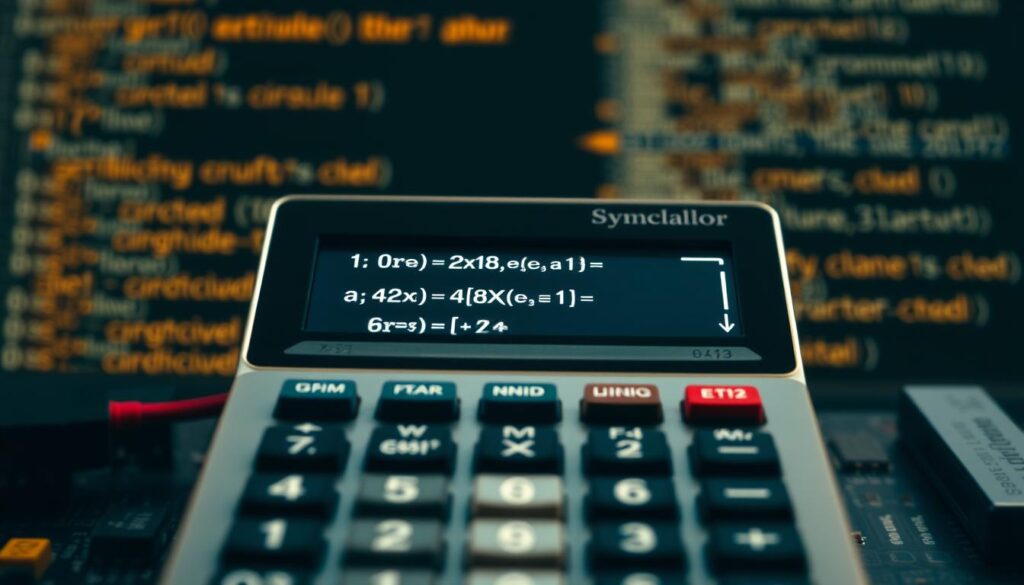Imagine being able to simplify complex mathematical expressions with just a few lines of code. Symbolic computation makes this possible, and it’s a powerful tool for anyone working with mathematical models.
Developing a symbolic calculator can seem daunting, but it can be achieved by breaking down the process into manageable steps. By choosing the right programming language, you can create a calculator that can perform various mathematical operations, from simple arithmetic to advanced calculus.
Key Takeaways
- Understand the basics of symbolic computation and its applications
- Choose a suitable programming language for symbolic calculator development
- Learn how to implement mathematical operations in your symbolic calculator
- Discover how to simplify complex expressions using your calculator
- Develop a fully functional symbolic calculator with step-by-step guidance
Understanding Symbolic Calculators
Symbolic calculators are revolutionizing the way we approach mathematical problems by allowing for the manipulation of symbols rather than just numbers. This capability opens up new avenues for solving complex mathematical expressions.
What Makes a Calculator “Symbolic”?
A calculator is considered “symbolic” when it can manipulate mathematical expressions using symbols, such as variables and constants, rather than just performing numerical computations. This allows for the simplification, differentiation, and integration of expressions, among other operations.
Differences Between Symbolic and Numeric Calculators
The primary difference between symbolic and numeric calculators lies in their approach to mathematical operations. While numeric calculators focus on numerical solutions, symbolic calculators provide exact solutions in terms of symbols and expressions.
Real-world Applications of Symbolic Computation
Symbolic computation has numerous applications in fields like physics, engineering, and mathematics, where complex expressions need to be manipulated and solved. For instance, symbolic calculators can be used to derive equations of motion or optimize complex systems.
Required Knowledge and Tools
The foundation of a successful symbolic calculator project lies in choosing the appropriate programming language and tools. When embarking on this journey, it’s essential to understand the options available.
Programming Languages Suitable for Symbolic Computation
Several programming languages are well-suited for symbolic computation. The choice often depends on the specific requirements of the project and the developer’s familiarity with the language.
Python, Java, and Lisp Comparisons
Python is renowned for its simplicity and extensive libraries, making it a popular choice. Java offers robustness and platform independence, while Lisp is historically significant in symbolic computation due to its macro capabilities.
- Python: Easy to learn, vast community, and libraries like SymPy.
- Java: Robust, platform-independent, but more verbose.
- Lisp: Powerful macro system, historically significant, but steeper learning curve.
Libraries and Frameworks to Consider
The right libraries and frameworks can significantly simplify the development process.
SymPy, Mathematica, and Maple Alternatives
SymPy is a Python library that offers a wide range of symbolic mathematics capabilities. Mathematica and Maple are commercial alternatives that provide comprehensive tools but at a cost.
- SymPy: Open-source, Python-based, and highly customizable.
- Mathematica: Commercial, comprehensive, and widely used in academia.
- Maple: Another commercial option with strong symbolic computation capabilities.
Setting Up Your Development Environment
To build a symbolic calculator, you need to start with a solid foundation – a well-configured development environment. This involves installing the necessary software and configuring your Integrated Development Environment (IDE).
Installing Necessary Software
The first step is to choose a suitable programming language for your symbolic calculator. Popular choices include Python and JavaScript, both of which have extensive libraries for symbolic computation.
Configuring Your IDE
Once you’ve installed your chosen programming language, you’ll need to configure your IDE. Popular IDEs like PyCharm and Visual Studio Code offer various extensions to enhance your development experience.
Recommended Extensions and Plugins
Consider adding plugins for code completion, debugging, and version control. For instance, Jupyter Notebook integration can be particularly useful for testing mathematical expressions.

Designing the Calculator Architecture
The architecture of a symbolic calculator plays a crucial role in determining its functionality and user experience. A well-structured architecture not only enhances the calculator’s performance but also makes it more maintainable and scalable.
Core Components of a Symbolic Calculator
A symbolic calculator is composed of several key components that work together to process mathematical expressions. Understanding these components is essential for designing an effective architecture.
Expression Representation Models
One of the critical aspects of a symbolic calculator is how it represents mathematical expressions. There are several models to consider, including:
- Tree representation, where expressions are structured as a tree data structure.
- Stack-based representation, which utilizes a stack to parse and evaluate expressions.
Choosing the right representation model depends on the specific requirements of your calculator and the types of mathematical operations it needs to support.
| Representation Model | Advantages | Disadvantages |
|---|---|---|
| Tree Representation | Efficient for complex expressions, easy to manipulate. | Can be memory-intensive for very large expressions. |
| Stack-based Representation | Simple to implement, efficient for simple expressions. | Limited in handling very complex expressions. |
Planning the User Interface
The user interface of a symbolic calculator is just as important as its internal architecture. It needs to be intuitive and user-friendly to ensure a positive user experience.
Command-line vs. Graphical Interfaces
When it comes to designing the user interface, developers have to decide between a command-line interface (CLI) and a graphical user interface (GUI). Each has its pros and cons.
“A command-line interface is more suitable for advanced users who are comfortable with typing commands, while a graphical interface is more accessible to a broader audience.”
A CLI offers more flexibility and power for complex operations, whereas a GUI provides an easier learning curve and more intuitive interaction.

In conclusion, designing the architecture of a symbolic calculator involves careful consideration of its core components and user interface. By choosing the appropriate expression representation model and interface type, developers can create a calculator that is both powerful and user-friendly.
How to Build a Symbolic Calculator Using a Programming Language
The process of building a symbolic calculator using a programming language involves several critical steps, starting with the choice of programming approach.
Choosing the Right Approach
When it comes to programming a symbolic calculator, the choice of programming paradigm can significantly impact the development process. Object-Oriented Programming (OOP) and Functional Programming (FP) are two popular paradigms that can be employed.
Object-Oriented vs. Functional Programming Paradigms
- Object-Oriented Programming organizes code around objects and their interactions, making it suitable for complex, stateful calculations.
- Functional Programming emphasizes pure functions and immutability, which can simplify the development of mathematical expressions.
Choosing between OOP and FP depends on the specific requirements of your calculator and your familiarity with each paradigm.

Implementing the Basic Structure
Once you’ve chosen your programming approach, the next step is to implement the basic structure of your symbolic calculator.
Creating the Main Calculator Class
The main calculator class serves as the backbone of your application, encapsulating the core functionality. When designing this class, consider the following:
- Define the class’s responsibilities and how it will interact with other components.
- Implement methods for basic mathematical operations, such as addition and subtraction.
- Plan for extensibility to accommodate advanced mathematical functions.
By carefully planning and implementing the main calculator class, you can build a robust foundation for your symbolic calculator.
Parsing Mathematical Expressions
To build a robust symbolic calculator, understanding how to parse mathematical expressions is crucial. Parsing is the process of analyzing a string of symbols, either in natural language or in a programming language, into a structured form that a computer can understand. In the context of a symbolic calculator, this means breaking down mathematical expressions into components that can be processed.

Creating a Lexer for Tokenization
A lexer, or tokenizer, is responsible for breaking the input string into tokens. These tokens are the basic building blocks of the mathematical expression, such as numbers, operators, and variables. Tokenization is a critical step as it converts the raw input into a format that can be analyzed further.
Handling Different Types of Tokens
Different types of tokens require different handling mechanisms. For instance, numerical tokens need to be recognized and processed differently from operator tokens. Variables also need to be identified and stored for later use. Effective tokenization ensures that the calculator can understand and process a wide range of mathematical expressions.
Building a Parser for Expression Trees
Once the input is tokenized, the next step is to build a parser that constructs an expression tree from the tokens. This tree represents the mathematical expression in a structured form that can be evaluated or manipulated symbolically. The Shunting-Yard algorithm is a popular method for parsing mathematical expressions into expression trees.
Implementing Shunting-Yard Algorithm
The Shunting-Yard algorithm, developed by Edsger Dijkstra, is a method for parsing mathematical expressions into Reverse Polish Notation (RPN), which can then be used to create an expression tree. This algorithm is particularly useful for handling expressions with multiple operators and parentheses, ensuring that the operations are performed in the correct order. By implementing the Shunting-Yard algorithm, you can significantly enhance the capabilities of your symbolic calculator.
By following these steps and understanding the importance of parsing in a symbolic calculator, you can create a robust and user-friendly symbolic calculator tutorial or guide for coding symbolic calculator applications.
Implementing Basic Arithmetic Operations
A symbolic calculator’s ability to perform arithmetic operations is fundamental to its utility. Implementing these operations effectively is crucial for the calculator’s overall functionality.
Addition and Subtraction
When implementing addition and subtraction, it’s essential to handle both constants and variables. This involves creating algorithms that can simplify expressions by combining like terms.
Handling Terms with Variables
Terms with variables require special handling, as they may involve different variables or the same variable with different exponents. Your implementation should be able to identify and combine like terms while keeping unlike terms separate.
Multiplication and Division
Multiplication and division operations are more complex, as they involve not just the operation itself but also simplifying the resulting expressions. This includes handling coefficients and variables appropriately.
Dealing with Fractions and Rational Expressions
Fractions and rational expressions add another layer of complexity. Your implementation should simplify these expressions by finding common denominators, cancelling out common factors, and handling division by zero appropriately.

By carefully implementing these basic arithmetic operations, you can ensure that your symbolic calculator is both robust and useful for a wide range of mathematical tasks.
Adding Support for Variables and Constants
A key step in developing a comprehensive symbolic calculator is implementing support for variables and constants. This enhancement allows users to define and manipulate variables and utilize common mathematical constants, making the calculator more versatile and user-friendly.
Handling Variable Declarations
To handle variable declarations effectively, your calculator needs to parse and store variable names along with their assigned values or expressions. This involves creating a data structure, such as a hash table or dictionary, to store the variables.
Variable Scope and Lifetime
Understanding variable scope and lifetime is crucial for managing how variables are accessed and modified within different parts of the calculator. Scope refers to the region of the code where a variable is defined and accessible, while lifetime refers to the duration for which the variable exists in memory.
Implementing Common Mathematical Constants
Common mathematical constants like π and e are frequently used in mathematical expressions. Implementing these constants requires careful consideration of their precision.
Precision Considerations for π, e, and Others
The precision of mathematical constants can significantly impact the accuracy of calculations. For instance, π and e can be represented to varying degrees of precision depending on the requirements of your calculator.
| Constant | Approximate Value | Precision |
|---|---|---|
| π | 3.14159 | 5 decimal places |
| e | 2.71828 | 5 decimal places |
By implementing variables and constants effectively, you can significantly enhance the functionality and usability of your symbolic calculator, making it a more powerful tool for users.
Developing Advanced Mathematical Functions
Developing advanced mathematical functions is a key step in building a sophisticated symbolic calculator. These functions enable your calculator to perform complex calculations, making it a valuable tool for users.
Trigonometric Functions
Trigonometric functions are essential for various mathematical and scientific applications. Implementing these functions involves creating algorithms that can handle trigonometric identities and equations.
Symbolic Manipulation of Trig Identities
Symbolic manipulation of trigonometric identities allows your calculator to simplify complex expressions. This involves applying trigonometric identities to transform expressions into simpler forms.
Logarithmic and Exponential Functions
Logarithmic and exponential functions are critical components of a symbolic calculator. These functions are used in various mathematical models and are essential for advanced calculations.
Simplification Rules for Logarithms
Implementing simplification rules for logarithms enables your calculator to simplify complex logarithmic expressions. This involves applying logarithmic identities and properties to reduce expressions to their simplest form.
By incorporating these advanced mathematical functions, you can significantly enhance the capabilities of your symbolic calculator, making it a more powerful tool for users.
Implementing Symbolic Differentiation
One of the key features of a symbolic calculator is its ability to perform symbolic differentiation. This powerful capability allows users to compute derivatives symbolically, making it an indispensable tool for advanced mathematical operations.
Understanding Differentiation Rules
To implement symbolic differentiation, it’s crucial to understand the underlying differentiation rules. These rules form the foundation of how your calculator will compute derivatives.
Chain Rule, Product Rule, and Quotient Rule
The chain rule, product rule, and quotient rule are fundamental to symbolic differentiation. The chain rule is used for differentiating composite functions, the product rule for differentiating products of functions, and the quotient rule for differentiating quotients of functions. Understanding and implementing these rules correctly is vital for accurate derivative computation.
Coding the Differentiation Engine
With a solid grasp of differentiation rules, you can proceed to code the differentiation engine. This involves translating the mathematical rules into a programming language that your symbolic calculator can execute.
Recursive Approaches to Differentiation
A recursive approach is often employed when coding the differentiation engine. This involves breaking down complex derivatives into simpler components, applying differentiation rules recursively until the derivative is fully computed. Recursive functions are particularly useful for handling nested functions and complex expressions.
By combining a thorough understanding of differentiation rules with a well-implemented recursive approach, you can create a robust differentiation engine for your symbolic calculator. This not only enhances the calculator’s functionality but also its value to users who rely on it for complex mathematical computations.
Testing and Optimizing Your Calculator
After successfully implementing the core functionality of your symbolic calculator, it’s crucial to ensure its reliability and performance through rigorous testing and optimization. This step is vital in any symbolic calculator project to guarantee that the calculator operates as expected under various conditions.
Unit Testing Symbolic Operations
Unit testing is a critical process that involves verifying each component of your calculator to ensure it functions correctly. When creating test cases, it’s essential to consider edge conditions that might cause your calculator to fail. For instance, division by zero or handling very large numbers.
Creating Test Cases for Edge Conditions
Edge conditions can reveal potential weaknesses in your implementation. By systematically testing these conditions, you can identify and fix issues before they become problematic. This proactive approach enhances the overall reliability of your symbolic calculator tutorial-based project.
Performance Optimization Techniques
Once your calculator is functionally correct, optimizing its performance is the next step. Techniques such as memoization and expression caching can significantly improve the efficiency of your calculator.
Memoization and Expression Caching
Memoization involves storing the results of expensive function calls so that they can be reused instead of recomputed. Expression caching works similarly by caching the results of expressions. These techniques can dramatically reduce computation time, especially for complex calculations. Implementing these optimizations will make your symbolic calculator more responsive and user-friendly.
Conclusion
Creating a symbolic calculator using a programming language is a challenging yet rewarding project. By following this step-by-step guide, you’ve gained the knowledge and skills necessary to develop a sophisticated calculator that can handle various mathematical operations.
To build a symbolic calculator, you’ve learned how to design the architecture, parse mathematical expressions, and implement basic arithmetic operations. You’ve also discovered how to add support for variables, constants, and advanced mathematical functions, including symbolic differentiation.
With a programming language symbolic calculator, you can simplify complex calculations, making it a valuable tool for students, educators, and professionals. By applying the skills you’ve acquired, you can further enhance your calculator and explore new applications, such as computer algebra systems or numerical analysis.
Now that you’ve completed this project, you can experiment with different programming languages and libraries to optimize your calculator’s performance. By doing so, you’ll continue to improve your skills in programming and mathematical problem-solving, opening up new possibilities for how to build a symbolic calculator using a programming language.
